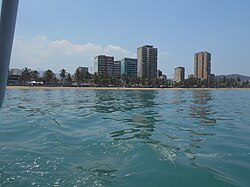Barcelona, Anzoátegui
| Barcelona | ||
|---|---|---|
| City | ||
 |
||
|
||
| Coordinates: 10°07′N 64°43′W / 10.117°N 64.717°WCoordinates: 10°07′N 64°43′W / 10.117°N 64.717°W | ||
| Country |
|
|
| State | Anzoátegui | |
| Municipality | Simón Bolívar, Anzoátegui | |
| Founded | 1671 | |
| Area | ||
| • Total | 76.5 km2 (29.5 sq mi) | |
| Elevation | 13 m (43 ft) | |
| Population (2010) | ||
| • Total | 620,555 | |
| • Density | 8,100/km2 (21,000/sq mi) | |
| Demonym(s) | Barcelonés/a | |
| Time zone | UTC (UTC-4:30) | |
| Postal Code | 6001 | |
| Area code(s) | 0281 | |
| Climate | BSh | |
Barcelona is the capital of Anzoátegui State, Venezuela and was founded in 1671. Together with Puerto La Cruz, Lecheria and Guanta, Barcelona forms one of the most important urban areas of Venezuela with a population of approximately 950,000.
Unlike Puerto La Cruz, which was mostly built in the 20th century, Barcelona has a mish-mash of historical and modern architecture from its several years of growth and development. The settlement of Nueva Barcelona del Cerro Santo (English: New Barcelona of the Holy Mountain), was originally established by the Spanish conquistador Joan Orpí (a native of Piera, Catalonia in Spain). It was later re-founded and populated by governor Sancho Fernández de Angulo two kilometres from the original settlement, and by a small community of Catalan colonists around 1671. Barcelona was one of the provinces under the governmental authority of the New Andalusia Province (Nueva Andalusía, or New Andalusia), and referred to commonly as New Barcelona. One of the remaining buildings of this period is the Museo de Anzoátegui, considered the oldest building in the city.
Many of the historical areas of Barcelona centre its main plazas: Bolivar, Miranda and Boyacá. The Plaza Boyacá was the main settlement in Barcelona, and is fronted by the Iglesia El Carmen (English: Carmelite Church) and the city's cathedral, the Catedral de San Cristobal (English: Cathedral of Saint Christopher), built between 1748 and 1773. Today, the cathedral houses the embalmed remains of San Celestino in a glass reliquary in a chapel off the main nave, which dates back to 1744.
By 1761, the territory had been delineated by the population of Pozuelos (to the north), west to the headlands of the River Unare, east to the Guanipa plateau and south to the Orinoco River.
After forced abdications of the King by Napoleon Bonaparte, the Spanish territories in the Americas began to agitate for autonomy. In Venezuela a series of Junta governments took authority in the name of the deposed King Ferdinand after 19 April 1810, that led to the formation of local juntas. A meeting was convened in the city of Barcelona to proclaim the independence of the province of Barcelona (which included both the district of Barcelona and the province of Cumana), on the 27 April. On 11 July 1810, the Supreme Junta of Caracas included Barcelona Province as one of the provinces that did not recognize the authority of the Spanish government. This led to a civil conflict between those who wanted independence from the Spanish crown and many who still recognized the authority of Spain.
...
Wikipedia


